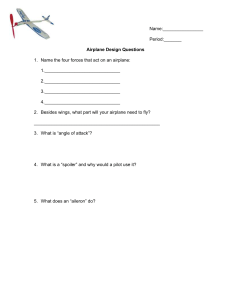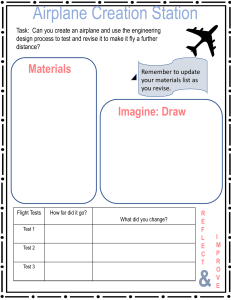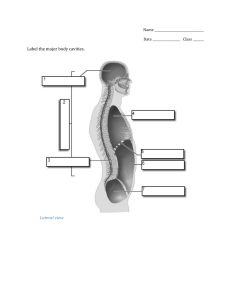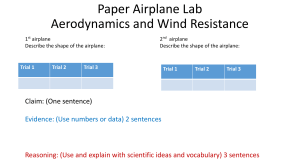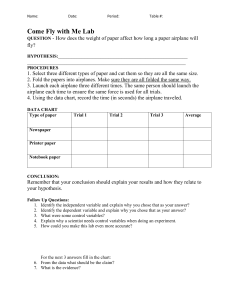NASA TN D-5700: Airplane Wind Tunnel Investigation
advertisement
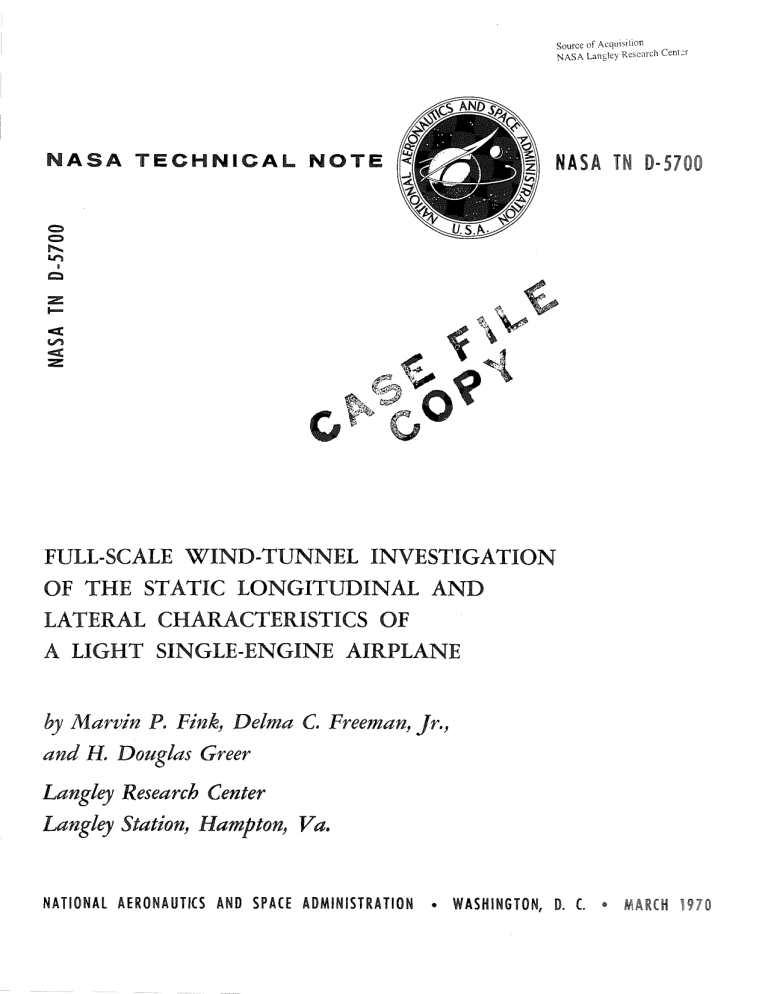
NASA TECHNICAL NOTE N A S A TN D-5700 0 0 FULL-SCALE WIND-TUNNEL INVESTIGATION OF THE STATIC LONGITUDINAL A LATERAL CHA CTERISTICS OF A LIGHT SINGLE-ENGINE AIRPLANE by Marvin P. Fink, Delma C. Freeman, Jr., and H. Dogglus Greer Langley Research Center La%& Station, Hampton, Va. NATIONAL AERONAUTICS AND SPACE ADMINISTRATION WASHINGTON, D. C. MARCH 1970 1. Report No. 2. Government A c c e s s i o n No. 3. Recipient's Catalog No. NASA TN D-5700 4. T i t l e and Subtitle 5. Report Date M a r c h 1970 FULL-SCALE WI NO-TUNNEL INVESTIGATION OF THE STATIC LONGITUDINAL / - 6. Performing Organization Code AND LATERAL CHARACTERISTICS OF A LIGHT S I NGLE-ENGINE AIRPLANE 8. Performing Organization Report No. L-7012 M a r v i n P. Fink, Delma C. Freeman, Jr., and H. Douglas Greer 10. Work U n i t No. 736-01-10-01-23 9. Performing Organization Name and Address 11. Contract or Grant No. NASA Langley Research Center Hampton, Va. 23365 13. T y p e o f Report and P e r i o d Covered 12. Sponsoring Agency Name ond Address I Technical Note National Aeronautics and Space Administration i Washington, D.C. 20546 14. Sponsoring Agency Code 15. Supplementary N o t e s 16. Abstroct The airplane was a light single-engine low-wing monoplane. Tests were made over a n angle-of-attack range of -40 t o 200 and over a sideslip range of Soat t h r u s t coefficients of T; = 0, 0.24 and 0.46. Control effectiveness was taken for a f u l l range of deflections on t h e aileron, elevator, rudder, and flap. Downwash measurements at tail were also obtained for t h e range of t h r u s t coefficient and flap deflection. 17. K e y Words Suggested by Author(s1 118. Light single-engine airplane D i s t r i b u t i o n Statement Unclassified - Unlimited Stability and control Tail downwash I 19. Security Classif. ( o f t h i s report) Unclassified 20. Security C l a s s i f . ( o f t h i s page) Unclassified 21- No. o f Pages 138 "For sale by t h e Clearinghouse for Federal Scientific and Technical Information Springfield, Virginia 22151 1 22. p r i c e B $3.00 FULL-SCALE WND-TUNNEL INVESTIGATION OF THE STATIC LONGITUDINAL AND LATERAL CHARACTERISTICS O F A LIGHT SINGLE-ENGINE AIRPLANE By Marvin P. Fink, Delma C. Freeman, Jr., and H. Douglas Greer Langley Research Center SUMMARY A force test investigation has been conducted in the Langley full-scale tunnel -to determine the static longitudinal and lateral stability and control characteristics of a full-scale, light, single -engine airplane. The investigation was made over an angle -of attack range of -4O to 20' a t various angles of sideslip between 58' for various power and flap settings. The power conditions were a thrust coefficient T: of zero which represents either a low-power or a high-speed condition (where the thrust coefficient approaches zero), T; = 0.20 which corresponds to a climb condition, and T; = 0.46 which corresponds to a take-off condition. The investigation showed that the airplane has stick-fixed longitudinal stability ior angles of attack up t o and through the stall for all configurations tested with the center of gravity located at 0.10 mean aerodynamic chord. Power generally has a small destabilizing effect but the airplane is statically stable even with the most rearward center-ofgravity location. The airplane is directionally stable and has positive effective dihedral through the stall for all conditions tested. The aileron and rudder effectiveness viras maintained through the stall and was powerful enough to t r i m out all airplane moments through the stall. INTRODUCTION For the past several years the NASA Flight Research Center has been concluetishg a program t o evaluate the flying qualities of a number of general aviation aircraft. The results of these investigations have been reported in reference 1. As a part of the eontinuing investigation, one of the airplanes investigated in reference 1, a light twin-engine configuration, was tested in the Langley full-scale tunnel, and the results have been reported in reference 2. The next phase of the wind-tunnel program was to investigate the characteristics of the single-engine version of the airplane of reference 2. The investigation was made to determine the static longitudinal and lateral stability and control characteristics with various power and flap settings over a range of angles of attack from -4O t o 2Q0 and over a range of sideslip angles of *8'. The t e s t s except those at thrust coefficients of 0.46 and 0.55 were made at a tunnel speed of about 9 3 feet per second which gives a Reynolds number of approximately 2.96 X lo6. T e s t s at 0.46 and 0.55 thrust coefficient were made at tunnel speeds of 54.8 and 77.0 feet per second, r e speetiv ely . SYMBOLS Figure 1 shows the stability-axis system used in the presentation of the data and the positive direction of forces, moments, and angles. The data a r e computed about the moment center shown in figure 2 which is at airplane longitudinal station 85, o r 10.0 percent of the mean aerodynamic chord and 1.0 f t (0.30 m) below the reference line. wing span, 35.98 ft (10.97 m) b 1) drag coefficient, Drag/qS "L, lift coefficient, ~ i f t / q S Crr, pitching-moment coefficient, Pitching moment/q~c ell yawing-moment coefficient, Yawing moment/qSb C~ rolling-moment coefficient, Rolling moment/qSb CY side-force coefficient, Side force/qS lC 1 @ ~ o l lift-curve slope at cu = 0°, untrimmed lateral stability parameter C z ~ Cnp directional stability parameter - longitudinal stability parameter ~ C L 'l8,a C%,r 2 aileron effectiveness parameter rolling effectiveness of rudder - aCm , Per deg horizontal-tail effectiveness parameter, yawing effectiveness of aileron rudder effectiveness parameter, -, per deg 8%- mean aerodynamic chord, 5 f t (1.53 m) propeller diameter, 6.42 ft (1.96 m) propeller speed, revolutions/sec free-stream dynamic pressure, lbf/ft% ( ~ / m 2 ) ratio of dynamic pressure at tail to free-stream dynamic pressure wing area, 178 ft2 (16.50 m2) effective Dragpropellers removed - Dragpropellers operating thrust coefficient, T/qS at a = O0 free-stream velocity, ft/sec (m/sec) propeller advance ratio longitudinal axis angle of attack of fuselage reference line, deg angle of sideslip, positive when nose is to left, deg total aileron deflection, positive when right aileron is down, (6a)Left - (6a)Righty deg flap deflection, positive when trailing edge is down, deg rudder deflection, positive when trailing edge is left, deg horizontal-tail deflection, positive when trailing edge is down, deg E downwash angle at tail, deg Subscript: max maximum AIRPLANE The airplane tested was a light, single-engine, low-wing monoplane having a maximum take-off weight of 3100 lb (13 800 N). Figure 2 gives the principal dimensions and figure 3 shows the airplane mounted in the tunnel test section. The airplane had a wing span of 35.98 feet (10.97 m), a wing a r e a of 178 ft2 (16.50 m2), an aspect ratio of 7.3, and a mean aerodynamic chord of 5 feet (1.53 m) based on projection of the outboard leading edge of the wing through the fuselage. The wing airfoil section was a modified NACA 642A215 airfoil with the trailing-edge cusp faired out. The wing had 5O of geometric dihedral and was at 2O positive incidence with respect to the fuselage reference line. Normally the airplane wing has no twist, but measurements of the test vehicle taken at the wing root and wing tip showed that the left wing tip had lo of positive incidence with respect to the wing root. Power was provided by a variable-frequency electric motor. The thrust axis was canted 3O to right and 2.75O downward to the reference line. The airplane had a standard three-control system. The horizontal tail was of the all-movable type with a travel of 3.4O to -12.8O. The horizontal tail had a geared trailing-edge tab which moved in the same direction as the tail with a deflection ratio (tab deflectionltail deflection) of 1.5. The travel of each aileron was from 15O to -17.80. The rudder travel was *25O. TESTS The tests were made to determine the static longitudinal and lateral stability and control characteristics of the airplane over a wide range of flight conditions. The airplane was tested over an angle-of-attack range of -4' to 20° and over a sideslip range of i8O for the clean condition (6f = 0°, gear up) and for 15' and 32' flap deflections with gear down. A range of tail incidence angles from 3.4O to -18.8O was investigated at zero sideslip, and the aileron and rudder effectiveness was measured over the sideslip range. The tests were made at thrust coefficients of T: = 0, 0.20, and 0.46 which represent flight conditions of low power o r high speed, a climb at best angle at about 90-percent power, and at full power as in take-off, respectively. The test thrust coefficients were based on . installed horsepower of 260 Several tests were made at a thrust coefficient of 0.55 which would be representative of a 355 horsepower engine . The propeller blade angle. and consequently the advance ratio. for each thrust coefficient was set at a fixed value which was representative of that for flight conditions a t which the particular value of thrust coefficient could be achieved. The values of V/nD were 0.98, 0.49, 0.33, and 0.33 for values of T; of 0. 0.20, 0.46, and0.55, respectively . Apropeller blade angle of 19.5O was set for T; = 0 and 0.46; and 230 was used for T; = 0.20. Tail downwash surveys were made along the horizontal tail hinge axis with the tail off at zero sideslip for flap deflections of OO. 15O. and 32O for T; = 0. 0.20, and 0.46. PRESENTATION OF DATA The data from these tests have been corrected for airstream misalinement. horizontal buoyancy effects. mounting strut tares. and wind-tunnel jet -boundary effects . The data a r e presented in the following figures: Figure 4 Longitudinal characteristics with propeller removed . . . . . . . . . . . . . . . Longitudinal characteristics with propeller removed and zero thrust . . . . . . 5 6 to 8 Longitudinal characteristics with power and flap deflection . . . . . . . . . . . Longitudinal characteristics with horizontal tail removed . . . . . . . . . . . . 9 10 Variation of pitching-moment coefficient with tail deflection . . . . . . . . . . . Lateral characteristics with propeller removed . . . . . . . . . . . . . . . . . 11 Lateral characteristics with power and flap deflections . . . . . . . . . . . . . 12 to 14 Lateral characteristics with vertical tail removed . . . . . . . . . . . . . . . .15 and 16 Lateral characteristics with aileron deflection. 6f = o0 . . . . . . . . . . . . . 17 and 18 . . . . . . . . 19 and 20 Lateral characteristics with aileron deflection. 6f = 32O . Lateral characteristics with rudder deflection. 6f = O0 . . . . . . . . . . . . 21 to 24 . . . . . . . . 25 to 28 Lateral characteristics with rudder deflection. 6f = 32O . Lateral stability characteristics with propeller removed . . . . . . . . . . . . 29 30 Lateral stability characteristics with propeller removed and at zero thrust . . . 31 Lateral and directional stability characteristics with vertical tail removed . . . . . . . . . . . . . . . . . . . . . . . . . . . . . . . . . . . . . 32 to 34 Downwash at tail Dynamic pressure at tail . . . . . . . . . . . . . . . . . . . . . . . . . . . . . . 35 to 37 38 Effect of power on longitudinal characteristics . . . . . . . . . . . . . . . . . . 39 Effect of power on lift-curve slope and maximum lift coefficient . . . . . . . . 40 Effect of power on longitudinal stability . . . . . . . . . . . . . . . . . . . . . . Effect of power on horizontal-tail control power . . . . . . . . . . . . . . . . .41 and 42 43 Flow conditions of tail . . . . . . . . . . . . . . . . . . . . . . . . . . . . . . . 44 Effective dihedral characteristics . ................. . Directional stability characteristics . . . . . . . . . . Aileron effectiveness . . . . . . . . . . . . . . . . . . Yawing effectiveness of aileron . . . . . . . . . . . . . Rudder effectiveness . . . . . . . . . . . . . . . . . . Rolling effectiveness of rudder . . . . . . . . . . . . . Effect of power on rudder effectiveness . . . . . . . . . Comparison of rolling- and yawing-moment coefficients fo:r various power and flap deflections . . . . . . . . Control capability . . . . . . . . . . . . . . . . . . . . ............. ............. Figure 45 and 46 47 48 49 50 51 ............. ............. 52 53 . . . . . . . . . . . . . . . . ............ . . . . . . . . . . . . . . . . . . . . . . . . RESULTS AND DISCUSSION The basic data obtained during the wind-tunnel investigation a r e presented in figu r e s 4 to 37 without analysis. Summary plots have been prepared from some of these data to illustlrate the general static stability and control characteristics of the airplane. Only the summary plots a r e discussed. Longitudinal Characteristics The longitudinal characteristics of the airplane with various power conditions a r e As might be expected, presented i n figure 38 for flap deflections of 0°, 15O, and 32'. increasing power results in an increase in lift-curve slope and maximum lift coefficient because of the increased slipstream velocity over the wing. This effect of power on the lift characteristics is summarized in figure 39 where lift-curve slope and maximum lift coefficient a r e shown a s functions of thrust coefficient. The pitching-moment curves shown i n figure 38 a r e virtually linear through the stall and do not exhibit the nose-down pitching moment at the stall usually associated with a straight-wing airplane. The variation of the pitching-moment curves with angle of attack indicates that increasing thrust has little effect on the longitudinal characteristics except for a t r i m change. These power effects a r e further illustrated in figure 40 where .the variation in static margin acm/8cL with thrust coefficient is presented. These data a r e a measure of the stick-fixed stability and show that power is destabilizing. The effects a r e generally small, however, and the airplane would have high static stability (even a t the aft center -of -gravity location (longitudinal station 92 o r 0.22c). The variation of horizontal-tail effectiveness with angle of attack is presented in figure 41 for flap deflections of oO, 15O, and 32O. These data show that there is a relatively small reduction in tail effectiveness a t the higher angles of attack, particularly with flaps down, and that the general level of tail effectiveness is little affected by flap deflection for a given power condition. The tail effectiveness is presented a s a function of thrust coefficient in figure 42 for each flap deflection of the tests. These data show that power.increased the tail effectiveness as would be expected, the slipstream acting on part of the tail. Presented in figure 43 is the variation of -the average downwash angle and the dynamic pressure ratio at the tail with angle of attack for the flap and power conditions investigated. These data were obtained from surveys and show a large increase in downwash angle with flap deflection. Also, there is little effect of power on the downwash angle except for tif = 32O and T: = 0.46. The dynamic-pressure ratio is relatively unaffected by flap deflection but increases with power, a s might be expected. Lateral Characteristics The variation of the effective-dihedral parameter Cz with angle of attack is P shown in figure 44 for the various flap and power conditions of the test. The data show that the airplane has positive effective dihedral (-CZ~)in all conditions except for Of = 32O and T; = 0.55 where Cz is about zero in the middle angle-of-attack range. P The value of -CzP varies widely depending upon the angle of attack, flap, or power condition; this statement means the response of the airplane to gusts or to rudder inputs to raise a wing could vary with the airplane configuration and flight condition. The variation of the directional stability parameter Cn with angle of attack is P shown in figure 45 for the various flap and power conditions. These data show that the airplane is directionally stable in all conditions over the entire angle-of -attack range. As was the case for the effective dihedral, the value of C nP varies considerably for the different conditions. The effect of power on the directional stability characteristics is presented in figure 46 and shows that power causes a large increase in the directional stability as would be expected because of the increase in dynamic pressure at the tail caused by the slipstream. The variation of the aileron rolling moments with angle of attack for sideslip angles of 00 and k8O is presented in figure 47 for flaps deflected o0 and 32O and T; = 0 and 0.46. These data show that in general, the aileron effectiveness remains at a fairly constant level throughout the angle-of -attack range and is relatively unaffected by flap deflection, power, or angle of sideslip. The variation of the aileron yawing moments with angle of attack is presented in figure 48 for the same flap and power conditions. These data show that the ailerons produce adverse yaw for all conditions and the magnitude of the yawing moment increases with increasing angle of attack. The variation of rudder effectiveness with angle of attack for sideslip angles from 8O to -8' is presented in figures 49 to 51 for all power conditions tested and for flap deflections of O0 and 32O. These data show that rudder effectiveness is maintained throughout the angle-of-attack range for all test conditions although there is some decrease in effectiveness near the stall, particularly for the negative sideslip conditions with high power. The effect of p m e r on the rudder effectiveness is presented in figure 51. The data show that the rudder effectiveness is more than doubled at maximum power because of the increased dynamic pressure at the tail cawed by the slipstream. The basic lateral characteristics of the airplane, a s shown by the variation of the lateral coefficients Ct and Cn with angle of attack for O0 sideslip, a r e presented in figure 52 for the various flap and power conditions of the test. The data show that below the stall, there is an out-of-trim positive rolling moment for all conditions that gradually reduces with-an increase in angle of attack. The rolling moment becomes negative near the stall. Tufts showed that the left wing starts to stall in the area aft of the intersection of the inboard glove and the wing leading edge. After the stall, the rolling moment might become positive again, depending upon the configuration. In a n . case, the rolling moments generated at the stall a r e not unusually large. The data also show that the application of power creates a negative yawing moment that increases with angle of attack up to about the stall and then decreases above the stall. This pawing moment is caused by the action of the slipstream on the vertical tail. An attempt has been made to determine whether the controls a r e pcrwexful enough to overcome the asymmetric moments near the stall, and the results of the analysis a r e presented in figure 53. In this figure is plotted the variation of the rolling and yawing Added to these moments with angle of attack at 00 sideslip for T; = 0.46 and 6f = 32'. curves a r e the moments available from full opposite aileron and rudder deflection (including the adverse yaw af the ailerons and the roll due to rudder deflection). These data show that based on static wind-tunnel results, the rolling and yawing moments available from aileron and rudder a r e more than adequate to trim out the airplane moments. CONCLUSIONS A full-scale wid-tunnel investigation has been made to determine the static longitudinal and lateral stability and control characteristics of a light single-engine airplane. The investigation was made over an angle-of-attack range of -4O to 20° at various angles for various power and flap settings. The following conclusions of sideslip between were drawn from the results.af the investigation: 1. The airplane has stick-fixed longitudinal stability through the stall for all configurations of the test, the center of gravity being located at 0.10 mean, aerodynamic chord. Power generally has a small destabilizing effect, but the airplane is statically stable even with the aft center-crf-gravib location. 2. The airplane is directionally stable and has positive effective dihedral through the stall for all conditions of the test. 3. Aileron and rudder effectiveness is maintained through the stall. 4. Aileron and rudder controls a r e powerful enough t o t r i m out a l l asymmetric. airplane moments through the stall. Langley Research Center, National Aeronautics and Space Administration, Langley Station, Hampton, Va., December 19, 1969. REFERENCES 1. Barber, Marvin R.; Jones, Charles K.; Sisk, Thomas R.; and Haise, F r e d W.: An Evaluation of the Handling Qualities of Seven General-Aviation Aircraft. NASA TN D-3726, 1966. 2. Fink, Marvin P.; and Freeman, Delma C., Jr. : Full-Scale Wind-Tunnel Investigation of Static Longitudinal and Lateral Characteristics of a Light Twin-Engine Airplane. NASA TN D-4983, 1969. orimntal reference In Figure 2.- Three-view drawing of airplane. A l l dimensions are in feet (meters). Figure 4.- Longitudinal aerodynamic characteristics of the airplane with propellers removed for several flap deflections. > [Ill - - ~ -- 1 - p - .- -- 1 - - (a) 6f = 6. Figure 5.- Comparison of the longitudinal characteristics of the airplane with propeller removed and zero thrust coefficient. - - . . 1 (b) bf = 15O. Figure 5.- Continued. ( c ) bf = 320. Figure 5.- Concluded. (a) Figure 6.- T; = 0. Longitudinal aerodynamic characteristics of the airplane for several thrust coefficients for 61 = 8. (b) T; = 0.20. Figure 6.- Continued. (c) Ti = 0.46. Figure 6.- Concluded. la) T: = 0. Figure 7.- Longitudinal aerodynamic characteristics of the airplane for several thrust coefficients. 6f = IS0. (b) T; = 0.20. Figure 7.- Continued. (c) T; = 0.46. Figure 7.- Concluded. (a) T[ = 0. Figure 8.- Longitudinal aerodynamic characteristics of the airplane for several thrust coefficients. bf = 32O. (b) T; = 0.20. Figure 8.- Continued. ( c ) T; = 0.46. Figure 8.- Concluded. (a) T; = 0. Figure 9.- Longitudinal aerodynamic characteristics of t h e airplane w i t h horizontal tail removed. (b) T; = 0.46. Figure 9.- Concluded. la) 6f = 8. Figure 11.- Lateral characteristics of the airplane with propellers removed for several flap deflections. (b) bf = .'51 Figure 11.- Continued. (c) bf = 32O. Figure 11.- Concluded. (0) T; = 0. Figure 12.- Lateral characteristics of the airplane for several sideslip angles and thrust coefficients for Sf = 8. Ib) T; = 0.20. Figure 12.- Continued. ( c ) T; = 0.46. Figure 12.- Continued. (d) T; = 0.55. Figure 12.- concluded. (a) *e 13:- T; = 0. Lateral chairacteristics of t h e airplane for several sideslip angles and t h r u s t coefficients for df = 15O. (b) T; = 0.20. Figure 13.- Continued. (c) T; = 0.46. Figure 13.- Continued. (d) Ti = 0.55. Figure 13.- Concluded. (a) T; = 0. Figure 14.- Lateral characteristics of t h e airplane for several sideslip angles and t h r u s t coefficients f o r 6f = 3Z0. (b) T; = 0.20. Figure 14.- Continued. ( c ) T; = 0.46. Figure 14.- Continued. (d) T; = 0.55. Figure 14.- Concluded. Figure 15.- Lateral characteristics of t h e airplane with t h e vertical tail removed for df = OO. (b) T; = 0.46. Figure 15.- Concluded. (a) T; = 0. Figure 16.- Lateral characteristics of t h e airplane w i t h the vertical tail removed for df = 320. Figure 16.- Concluded. (a) 31. = So. Figure 17.- Variation of t h e lateral characteristics of t h e airplane w i t h aileron deflection. 6f = 8 ; T; = 0. (b) p = 00. Figure 17.- Continued. Figure 17.- Concluded. (a) P = 8O. Figure 18.- Variation of t h e lateral characteristics of t h e airplane w i t h aileron deflection. bf = 0'; T; = 0.46. .1 0 -.1 0 -.02 -.04 .06 .04 .02 0 -,02 -.04 -,06 -40 -30 -20 -10 0 6,, (b) 10 deg p = oO. Figure 18.- Continued. 20 30 40 Figure 18.- Concluded. 0 -,1 .02 n 0 -.02 -06 -04 02 I1 -.02 -.04 -,06 -40 -30 -20 - 10 0 6a, deg (a) 10 20 30 40 p = 8O. Figure 19.- Variation of t h e lateral characteristics of t h e airplane with aileron deflection. = 320; T; = 0. Figure 19.- Continued. Figure 19.- Concluded. (a) Figure 20.- 8 = go. Variation of t h e lateral characteristics of the airplane with aileron deflection. 6f = 320; T; = 0.46. (b) p = 00. Figure 20.- Continued. (c) /3 = -80. Figure 20.- Concluded. 51 5 fiap lJg 01- 0 51- OZ- 51- (b) p = Figure 21.- 00. Continued. (c) Figure 21.- p = 8O. Concluded. (a) p = 8 0 . Figure 22.- Variation of t h e lateral characteristics of t h e airplane w i t h rudder deflection. 6f = OO; T; = 0.20. (b) p = 4". Figure 22.- Continued. (c) p = o o . Figure 22.- Continued. Figure 22.- Continued. Figure 22.- Concluded. (a) p = 8 O . Figure 23.- Variation of t h e lateral characteristics of t h e airplane w i t h rudder deflection. 6f = OO; T; = 0.46. Figure 23.- Continued. (c) Figure 23.- p = oO. Continued. (d) p Figure 23.- = -40. Continued. (e) p = -So. Figure 23.- Concluded. (a) Figure 24.- B = so. Variation of t h e lateral characteristics of t h e airplane w i t h rudder deflection. bf = OO; T; = 0.55. (b) p = 4O. Figure 24.- Continued. (c) Figure 24.- p = 00. Continued. (d) p = -4O. Figure 24.- Continued. (e) p = -8'. Figure 24.- Concluded. (a) Figure 25.- P = 80. Variation of t h e lateral characteristics of t h e airplane with rudder deflection. bf = 32O; T; = 0. (b) p = 0'. Figure 25.- Continued. (c) p = -8'. Figure 25.- Concluded. la) Figure 26.- p = 8O. Variation of t h e lateral characteristics of t h e airplane w i t h rudder deflection. 6f = 3Z0; T; = 0.20. (b) Figure 26.- p = 4O. Continued. (c) p = Figure 26.- oO. Continued. (d) p = -4'3. Figure 26.- Continued. (el p = -8O. Figure 26.- Concluded. (a) Figure 27.- P = so. Variation of t h e lateral characteristics of t h e airplane w i t h rudder deflection. bf = 320; T; = 0.46. (c) p = Figure 27.- 00. Continued. (d) p = -40. Figure 27.- Continued. (e) p = -80. Figure 27.- Concluded. la) p = 8O. Figure 28.- Variation of t h e lateral characteristics of t h e airplane with rudder deflection. bf = 32O; T; = 0.55. (b) p = 4O. Figure 28.- Continued. (c) Figure 28.- p = 00. Continued. Id) Figure 28.- = -4O. Continued. (e) p = -8O. Figure 28.- Concluded. Figure 29.- Variation of effective dihedral and directional stability parameters w i t h angle of attack. Propeller removed. -10 6 Left Figure 32.- 4 2 0 2 Lateral distance from center line, feet 4 6 8 Right Distribution of downwash across span of horizontal-tail surface. bf = 0'. Dashed lines are averages integrated over horizontal-tail span. Left Lateral distance from center line, feet (b) T i = 0.20. Figure 32.- Continued. Right 8 Left 6 4 2 0 2 Lateral distance from center line, feet (c) T; = 0.46. Figure 32.- Concluded. 4 6 8 Right E.. deg E, deg Left Figure 33.- Lateral distance from center line, feet Right Distribution of downwash across span of horizontal-tail surface. bf = 15O. Dashed lines are averages integrated over horizontal-tail span. 8 Left 6 4 2 0 2 Lateral distance from center line, feet (b) T; = 0.20. Figure 33.- Continued. 4 6 8 Right Left Lateral distance from center line, feet ( c ) T; = 0.46. Figure 33.- Concluded. Right Left Lateral distance from center line, feet Right Figure 34.- Distribution of downwash across span of horizontal-tail surface. bf = 320. Dashed lines a r e averages integrated over horizontal-tail span. Lateral distance from center line, feet (b) T; = 0.20. Figure 34.- Continued. Right 8 Left 6 4 2 0 2 Lateral distance from center line, feet ( c ) T; = 0.46. Figure 34.- Concluded. 4 6 8 Right Left Figure 35.- Lateral distance from center line. feet Right Distribution of dynamic pressure across span of horizontal-tail surface. 61 = OO. Dashed lines are averages integrated over horizontal-tail span. 4 Lateral distance from center line, feet (b) T i = 0.20. Figure 35.- Continued. 6 8 Right " 8 Left b Lateral distance from center line, feet (c) T; = 0.46. Figure 35.- Concluded. Right Left Lateral distance from center line, feet Right Figure 36.- Distribution of dynamic pressure across span of horizontal-tail surface. 6f = 15O. Dashed lines are averages integrated over span of horizontal tail. Left Lateral distance from center line, feet (b) T; = 0.20. Figure 36.- Continued. Right Lefl Lateral distance from center line, feet (c) T: = 0.46. Figure 36.- Concluded. Right 8 Lefl 6 4 2 0 2 Lateral distance from center line, feet 4 6 8 Right Figure 37.- Distribution of dynamic pressure across span of horizontal-tail surface. Dashed lines are averages integrated over span of horizontal tail. Q = 32O. 'It 9 41 9 st 9 qt 4' Left Lateral distance from center line, feet (b) T; Figure 37.- = 0.20. Continued. Right Left Lateral distance from center line, feel (c) 1; = 0.46. Figure 37.- Concluded. Right (a) = OO. Figure 38.- Effect of power on longitudinal characteristics. p = 8. (b) 6f = 15O. Figure 38.- Continued. (c) bf = 32O. Figure 38.- Concluded. Figure 40.- Stick-fixed power-on longitudinal stability characteristics for 0.1E center-of-gravity location. 0 .1 .2 .3 .4 .5 T;: Figure 46.- Effect of power on directional stability parameters. .6 m "Lo0 4 deg Id) p = -4O. Figure 49.- Concluded. ( a ) bf = 00. Figure 50.- Effect of rudder deflection on rolling-moment coefficient. (b) hf = 3Z0. Figure 50.- Concluded. Figure 51.- Effect of power on rudder effectiveness. la) Rolling-moment coefficients. Figure 52.- Variation of rolling-moment and yawing-moment coefficients with angle of attack. $ = Oo. (b) Yawing-moment coefficients. Figure 52.- Concluded.
